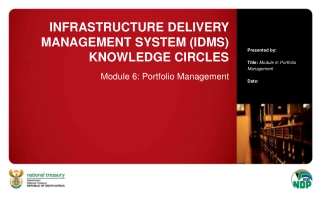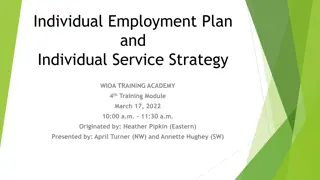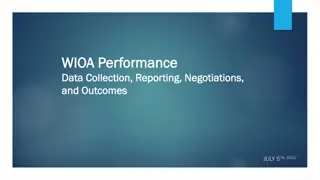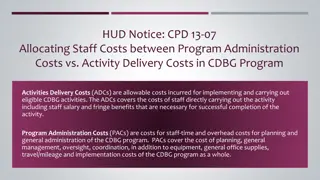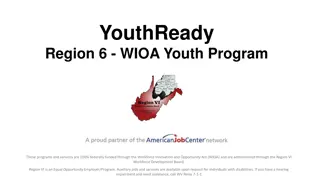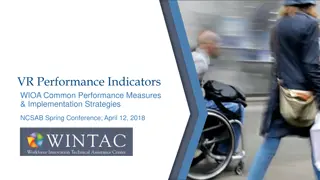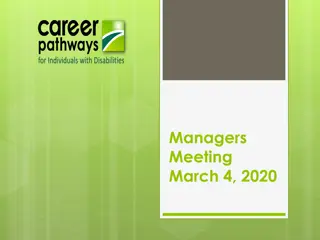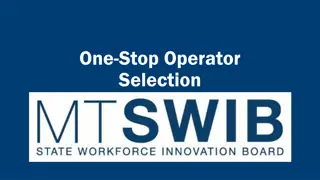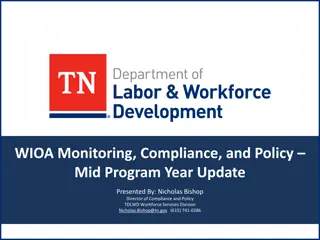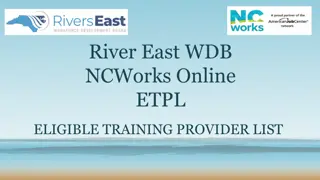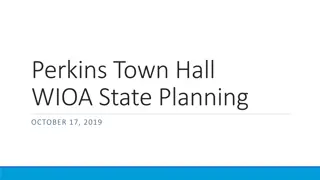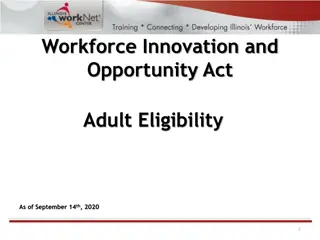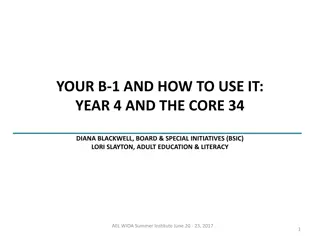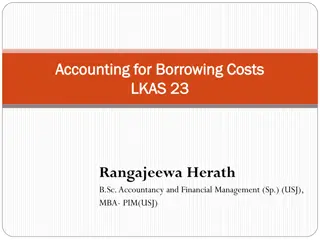Understanding One-Stop Delivery System and Infrastructure Costs under WIOA
This presentation discusses the guidance on developing MOUs with Texas workforce system partners, focusing on operation and funding of workforce services, including one-stop infrastructure costs. It covers topics such as common identifiers, operating budgets, infrastructure costs, funding methods, and more to support local workforce solutions systems.
Download Presentation

Please find below an Image/Link to download the presentation.
The content on the website is provided AS IS for your information and personal use only. It may not be sold, licensed, or shared on other websites without obtaining consent from the author. Download presentation by click this link. If you encounter any issues during the download, it is possible that the publisher has removed the file from their server.
E N D
Presentation Transcript
ONE-STOP DELIVERY SYSTEM AND INFRASTRUCTURE COSTS UNDER WIOA, PART 1 Anson Green Adult Education and Literacy Jason Vaden Workforce Program Policy Texas Workforce Commission 2/10/17
PRESENTERS Anson Green, State Director, Adult Education and Literacy Jason Vaden, Director, Workforce Program Policy
PURPOSE To provide guidance on relating to developing and entering into memoranda of understanding (MOUs) with statutorily required and optional Texas workforce system partners (partners) relating to the operation and funding of Texas workforce system services including the contribution of one-stop infrastructure costs
OUTLINE I. II. III. Common identifier IV. One-stop operating budgets and costs V. Infrastructure costs VI. Comprehensive vs affiliate sites VII. Infrastructure funding methods VIII. Third-party in-kind contributions IX. How to start Local workforce solutions system Memorandum of understanding
JOINT EFFORT AND MESSAGE Guidance jointly developed and released by the U.S. Departments of Labor (DOL), Education (ED), and Health and Human Services (HHS) TWC Adult Education and Literacy, Workforce Policy, and Finance are similarly collaborating to promote and support Boards and providers
FEDERAL SOURCES Program Memorandum OCTAE 17-3: Infrastructure Funding of the One-Stop Delivery System (also DOL TEGL 17-16) Program Memorandum OCTAE 17-3 Program Memorandum OCTAE 17-4: One-Stop Operations Guidance for the American Job Center Network (also DOL TEGL 16-16) Program Memorandum OCTAE 17-4 WIOA One-Stop Infrastructure Costs - FAQs , released 12/27/16 WIOA One-Stop Infrastructure Costs - FAQs Resource Sharing for Workforce Investment Act One-stop Centers: Methodologies for Paying or Funding Each Partner Program s Fair Share of Allocable One-Stop Costs 5/31/2001 Resource Sharing for Workforce Investment Act One-stop Centers Office of Management and Budget (OMB) CFR Chapter II, Part 200, et al. Uniform Administrative Requirements, Cost Principles, and Audit Requirements for Federal Awards; Final Guidance and Final Rule (Uniform Guidance) ). Final Guidance published at 78 FR 78589 (December 26, 2013) and Final Rule published at 79 FR 75867 (December 19, 2014). Uniform Guidance Department of Education (USED) 2 CFR 3474 (79 FR 76091, December 19, 2014). Uniform Administrative Requirements, Cost Principles, and Audit Requirements for Federal Awards, December 19, 2014. Uniform Guidance (ED) Department of Labor (DOL) One-Stop Financial Management Technical Assistance Guide (TAG), which can be found at One-Stop Financial Management Technical Assistance Guide
STATE SOURCES WD Letter 01-17: Texas Workforce System Partners Memoranda of Understanding, Including Infrastructure Funding Costs Update. WD Letter 01-17, Attachment 1 of WD 1-17 WD Letter 04-17: Common Identifier for Local Workforce Development Boards. WD Letter 04-17 Texas Workforce Commission, Financial Manual for Grants & Contracts. Financial Manual for Grants & Contracts Texas Comptroller of Public Accounts, Uniform Grant Management Standards (As adopted June 2004). Uniform Grant Management Standards
LOCAL WORKFORCE SOLUTIONS SYSTEM Part 1
TERMS State System One-stop delivery system (WIOA) Texas Workforce Solutions system (Texas) Local Offices One stop centers / American Job Centers (WIOA) Workforce Solutions Office (Texas)
VISION TEXAS WORKFORCE SOLUTIONS Provides vital workforce development tools that help workers find and keep good jobs, and help employers hire the skilled workers they need to grow their businesses. Workforce Solutions Offices, in collaboration with workforce partners, including community colleges, AEL, local independent school districts, economic development groups, and other state agencies provides innovative services to support employers and workers Collaboration and coordination across these agencies and local entities play a critical role in the success of the Texas workforce system
WHO ARE REQUIRED PARTNERS? WIOA adult, dislocated worker, and youth programs Supplemental Nutrition Assistance Program (SNAP) Employment and Training programs Wagner-Peyser Employment Service program Subsidized Child Care programs Adult Education and Literacy program Apprenticeship programs (Texas Education Code, Chapter 133) Vocational Rehabilitation (VR) program Veterans employment and training programs The unemployment insurance program The Trade Adjustment Assistance program National and Community Service Act of 2007 program Choices, the Temporary Assistance for Needy Families employment and training program Senior Community Service Employment Program; and Non-Certificate Postsecondary Career and Technology Training programs
AEL REQUIREMENT IN ONE-STOP DELIVERY SYSTEM Question: Does an AEL program have to be part of the one-stop delivery system, Memorandum of Understanding (MOU) and share infrastructure cost ? Answer: Yes, on November 2, 2016 TWC signed assurances with the US Department of Education related to designating AEL grant recipients as partners in the one-stop delivery system. The AEL Year 4 contract will include requirement.
MEMORANDUM OF UNDERSTANDING Part 2
MEMORANDUM OF UNDERSTANDING WIOA requires Boards, with the agreement of their chief elected officials, to develop and enter into MOUs with statutorily required partners regarding the operation and funding of Texas workforce system services by July 1, 2017. The MOU defines and binds the system Reference: WD 01-17, WIOA: Texas Workforce System Partners Memoranda of Understanding, Including Infrastructure Funding Costs
MOU, WHAT MUST BE IN IT? Memorandum of Understanding must include: Description of services, including how services will be coordinated and delivered How costs of services and operating costs will be funded, including infrastructure costs Referral methods individuals between Workforce Solutions Offices and partners Methods for ensuring that the needs of workers, youth, and individuals with barriers to employment are provided access, including access to technology and materials available Beginning and end dates and procedures for amending MOU Assurances that each MOU will be reviewed not less than once in every three-year period, and then renewed if substantial amendments have been made as a result of the review
DUE DATES AND CHECKLIST MOUs must be complete by July 1, 2017 Attachment 1 of WD 1-17 provides a detailed checklist on required and additional items that MOUs address. Attachment 1 of WD 1-17
SYSTEM FOCUS, NOT JUST CO-LOCATION Required-partner programs under WIOA and state law are system partners Focus is on providing customers with access to partner programs whether they are co-located in a Workforce Solutions Office or not Goal is bringing the most value to customers by leveraging organizational strengths and services as an interconnected system MOU and infrastructure costs apply to all, whether there is physical co-location or not
COMMON IDENTIFIER Part 3
BRANDING, COMMON IDENTIFIER Established by DOL and ED American Job Centers (AJCs) as a unifying name and brand that identifies the online and in-person workforce development services as part of a single network Boards must use the tagline a proud partner of the American Job Center network on all primary electronic resources and websites, as well as on any newly printed, purchased, or created materials
AEL AND THE USE OF THE COMMON IDENTIFIER (c) As of July 1, 2017, each one-stop delivery system must include the American Job Center identifier or a proud partner of the American Job Center network on all products, programs, activities, services, electronic resources, facilities, and related property and new materials used in the one-stop delivery system. (d) One-stop partners may use additional identifiers on their products, programs, activities, services, facilities, and related property and materials. AEL branding effort lead by AEL Advisory Committee
ONE-STOP OPERATING BUDGETS AND COSTS Part 4
MASTER BUDGET The financial plan or master budget to which the one- stop partners, CEO(s), and the Board in each local area have agreed Contains a set of individual budgets or components that identifies costs in the statute: Infrastructure costs Additional costs Must include applicable career services and May include shared operating costs and Shared services that are related to the operation of the one-stop delivery system but do not constitute infrastructure costs
ONE-STOP OPERATING COSTS One-Stop Operating Costs Infrastructure Costs Additional Costs Must include Applicable Career Services May include Shared Operating Costs and Shared Services
ONE-STOP OPERATING COSTS, CONT. One-Stop Operating Costs Future Webinar Infrastructure Costs Additional Costs Must include Applicable Career Services May include Shared Operating Costs and Shared Services
PERIODIC RECONCILIATION Budgets Must be periodically reconciled against actual costs incurred and adjusted accordingly Ensures that the budget reflects a cost allocation methodology that demonstrates how infrastructure costs are charged to each partner in proportion to the partner s use of the one-stop center and relative benefit received May be further refined by partners, as needed, to assist in tracking their contributions
INFRASTRUCTURE COSTS Part 5
WHAT ARE INFRASTRUCTURE COSTS? Non-personnel Costs Costs for the general operation of the one-stop center, including but not limited to: Applicable facility costs (such as rent) including costs of utilities and maintenance Equipment (including assessment-related products and assistive technology for individuals with disabilities) Technology to facilitate access to the one-stop center, including technology used for the center s planning and outreach activities May consider common identifier costs as costs of one-stop infrastructure May consider supplies to support the general operation of the one-stop center
NON-PERSONNEL MEANS NO STAFF Non-personnel costs are all costs that are not compensation for personal services BUT services performed by vendors or contractors are non-personnel costs and may be identified as infrastructure costs Service Contracts Necessary for the general operation of the one-stop center, such as: Technology-related Security
WHAT DOES NOT COUNT? Personnel Costs Are not Infrastructure Costs Personnel costs include salaries, wages, and fringe benefits of the employees of partner programs or their subrecipients Examples: Instructors in a AEL class at a one-stop cannot be used as infrastructure costs A greeter at a shared welcome desk who directs employers and customers to the one- stop services or staff cannot be used as infrastructure cost These would be personnel costs and would be identified as additional costs not infrastructure costs in the one-stop operating budget
CONTRIBUTION PARAMETERS Partner contributions must be consistent with the program s authorizing statute and regulations, as well as with the OMB Uniform Administrative Requirements, Cost Principles, and Audit Requirements for Federal Awards (Uniform Guidance)
NEW TO AEL, BUT NOT TO WORKFORCE Under the Workforce Investment Act costs were shared among partners, including infrastructure costs Outlined and funded through Resource Sharing Agreements between local boards and one-stop partners Funding arrangements were incorporated into the Memorandum of Understanding (MOU). Uniform policy on acceptable methodologies for cost allocation and resource sharing with respect to funding the one-stop delivery system Resource Sharing for Workforce Investment Act One-Stop Centers: Methodologies for Paying or Funding Each Partner Program s Fair Share of Allocable One-Stop Costs; Notice (2001) Also outlined in Part I of the One-Stop Financial Management Technical Assistance Guide DOL expected to update the Technical Assistance Guide to reflect the requirements of WIOA, the Uniform Guidance, in the near future
ALL PARTNERS CONTRIBUTE All one-stop partner programs must contribute to the infrastructure costs and certain additional costs of the one- stop delivery system based on their proportionate use A partner s contribution must be an allowable, reasonable, necessary, and allocable cost to the program, consistent with the Federal Cost Principles set forth in the Uniform Guidance
COSTS OF COMMON IDENTIFIER CAN BE INCLUDED Costs associated with the development and use of the common identifier and supplies may be considered allowable infrastructure costs Example: Signage changes related to inclusion of American Job Center tag line
PROPORTIONATE USE & RELATIVE BENEFIT Contribution to infrastructure costs are based on proportionate use and relative benefits received from the one-stop delivery system. Examples: Proportionate use: Does the AEL provider have a physical presence at the centers? Relative benefits received: To what extent does co-enrollment occur across partners?
PROPORTIONATE USE Proportionate use refers to a partner program contributing its fair share of the costs proportionate to: 1) The use of the one-stop center by customers that may include reportable individuals and participants in its program at that one-stop center 2) The amount of square footage occupied by the partner program in the one-stop center 3) Another allocation base consistent with the Uniform Guidance
RELATIVE BENEFIT Relative benefit received from participating in the one-stop delivery system is another step in the cost allocation process Determining relative benefit does not require partners to conduct an exact or absolute measurement of benefit, but instead to measure a partner s benefit using reasonable methods Uniform Guidance requires that the process of assigning a cost or group of costs to one or more cost objectives must be in reasonable proportion to the benefit provided The measurement of a one-stop partner s share of infrastructure costs must be based on reasonable methods that are agreed to by all partners Partner contributions that are initially based on budgeted amounts must be reviewed and reconciled periodically during the program year against actual costs incurred Adjustments must be made to ensure that partner contributions are proportionate to their use of the one-stop center and relative benefits received
SERVICE INTEGRATION REQUIRED The required one-stop partners must provide access to their programs in the comprehensive centers and contribute to the infrastructure costs of those centers. These partners also make available each partner program s applicable career services at the comprehensive one-stop centers and may contribute to shared services and shared operating costs.
COMPREHENSIVE VS AFFILIATE SITES Part 6
SITES DEFINED Comprehensive Site Affiliate Site An access point in addition to the comprehensive center A physical site where job seekers and employer customers can access the programs, services, and activities of all required one-stop partners Makes available one or more of the one-stop partners programs, services, and activities Does not need to provide access to every required one-stop partner program Can include any additional partners as determined by the Board. Frequency of program staff s physical presence in the affiliated site determined locally Each workforce area must have at least one comprehensive workforce center
EXAMPLES OF AFFILIATE SITES A full-time Workforce Solutions office at community college Workforce Solutions staff that are present at a public library, or other partner location, on an itinerant basis to provide services Mobile units that allow Workforce Solutions staff to travel to remote locations in order to provide services
AFFILIATE SITE & INFRASTRUCTURE COSTS Only those partners that participate in the affiliate one- stop center would be required to contribute to the infrastructure costs for those centers Includes one-stop affiliate centers where access to program, services, and activities are made available through a direct linkage or physical presence.
DIRECT LINKAGE Direct linkage can take many forms and means providing a direct connection at Workforce Solutions center within a reasonable time Can include phone or through a real-time web-based communication with to an AEL or other program staff member who can provide program information or services, including career services, to the customer. Solely providing a phone number, web site, information, pamphlets, or materials does not constitute a direct linkage
MULTIPLE AEL PARTNERS When two or more AEL grant recipients or subrecipients of a required partner program are carrying out the program in a local area, both of these entities must contribute to infrastructure costs, including at an affiliate center, if those partners are participating in that affiliate center. In workforce areas with more than one AEL grant recipient all grant recipients must contribute AEL consortia subrecipients must contribute
INFRASTRUCTURE FUNDING METHODS Part 7
3 CONTRIBUTION METHODS Cash Non-Cash Third-Party In-Kind Contributions of space, equipment, technology, non-personnel services, or other like items to support the infrastructure costs associated with one-stop operations, by a non-one- stop partner to: Support the one-stop center in general or Support the proportionate share of one-stop infrastructure costs of a specific partner Expenditures incurred by one- stop partners on behalf of the one-stop center; and Non-cash contributions or goods or services contributed by a partner program and used by the one-stop center Cash funds provided to the local board or its designee by one-stop partners, either directly or by an interagency transfer, or by a third party
NON-CASH & THIRD-PARTY IN-KIND More information is forthcoming from TWC
CASH CONTRIBUTIONS Contributions from the AEL programs must be from local administrative funds. Contributions made using administrative funds may not exceed the amount available for administrative costs under the authorizing statute or regulations of the partner program.
AEL ADMINISTRATIVE LIMITS AEFLA 231: No more than 5 percent administrative costs, as defined by AEFLA, provided, however, that the Special Rule outlined in AEFLA 233(b) shall apply with effective justification, as appropriate. (b) SPECIAL RULE. In cases where the cost limits described in subsection (a) are too restrictive to allow for the activities described in subsection (a)(2), the eligible provider shall negotiate with the eligible agency in order to determine an adequate level of funds to be used for noninstructional purposes. AEFLA 243 for EL/Civics: No more than 5 percent administrative costs, as defined by AEFLA TANF: No more than 15 percent of the funds Source: TWC rule and 800.68. Adult Education and Literacy and AEFLA
ADDITIONAL COSTS One-Stop Operating Costs Future Webinar Infrastructure Costs Additional Costs Must include Applicable Career Services May include Shared Operating Costs and Shared Services
HOW TO START Part 8


